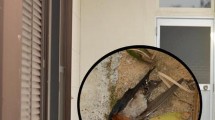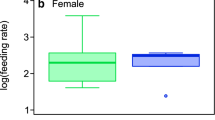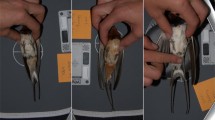Abstract
In dynamic selection regimes, an honest signal that indicates high quality in favorable environments might be negatively related to quality in unfavorable environments, though empirical evidence is scarce. Here, we studied the relationship between plumage ornaments and physiological state in the Pacific swallow Hirundo tahitica on Amami Oshima Island in 2 years with contrasting weather conditions: a once-in-a-century severe winter and a mild winter in the following year. Previous studies have shown that, during the severe winter, many Pacific swallows, particularly those with long tails, died whereas no carcasses were found in the next year, indicating relaxed selection during mild years. Here we showed that after the severe winter, the offspring generation had shorter tails than the parental generation, which could not be explained by age or yearly difference in tail length, indicating the evolution of short tails. Moreover, the relationship between tail length and body condition differed between years: longer-tailed swallows had a better body condition in the mild winter, whereas the reverse tendency was found in the severe winter. A similar relationship was found between plasma corticosterone level, an indicator of physiological stress, and tail length (i.e., swallows with longer tails tended to have lower corticosterone levels during the mild winter while the reverse pattern was found during the severe winter). In contrast, another plumage ornament, pheomelanin pigmentation, was positively linked to body condition during the two study years and had no detectable relationship with the plasma corticosterone levels. Differences in the relationship between specific plumage traits and physiology may help to explain the diversity of tail length and plumage coloration in hirundines.



Similar content being viewed by others
References
Andersson M (1994) Sexual selection. Princeton University Press, Princeton
Arai E, Hasegawa M, Makino T, Hagino A, Sakai Y, Ohtsuki H et al (2017) Physiological conditions and genetic controls of phaeomelanin pigmentation in nestling barn swallows. Behav Ecol 28:706–716
Arai E, Hasegawa M, Sato M, Sakai H, Ito S, Wakamatsu K (2019) Eumelanin levels in rufous feathers explain plasma testosterone levels and survival in swallows. Ecol Evol 9:2755–2764
Bates D, Maechler M, Bolker B (2011) lme4: linear mixed-effects models using S4 classes. R package version 0.99375-42
Bro-Jørgensen J (2010) Dynamics of multiple signaling systems: animal communication in a world in flux. Trends Ecol Evol 25:292–300
Brown CR, Brown MB (1998) Intense natural selection on body size and wing and tail asymmetry in Cliff Swallows during severe weather. Evolution 52:1461–1475
Buchanan KL, Evans MR (2000) The effect of tail streamer length on aerodynamic performance in the barn swallow. Behav Ecol 11:228–238
Chaine AS, Lyon BE (2008) Adaptive plasticity in female mate choice dampens sexual selection on male ornaments in the lark bunting. Science 319:459–462
Cornwallis C, Uller T (2009) Towards an evolutionary ecology of sexual traits. Trends Ecol Evol 25:145–152
Cuervo JJ, Møller AP (2006) Experimental tail elongation in male Barn Swallows Hirundo rustica reduces provisioning of young, but only in second broods. IBIS 148:449–458
d’Ischia M, Wakamatsu K, Cicoira F, Di Mauro E, Garcia-Borron JC, Commo S, Galván I, Ghanem G, Koike K, Meredith P, Pezzella A, Santato C, Sarna T, Simon JD, Zecca L, Zucca F, Napolitano A, Ito S (2013) Melanins and melanogenesis: from pigment cells to human health and technological applications. Pigment Cell Melanoma Res 28:520–544
de Lope F, Møller AP (1993) Female reproductive effort depends on the degree of ornamentation of their mates. Evolution 47:1152–1160
Evans MR (1998) Selection on swallow tail streamers. Nature 394:233–234
Gelman A, Hill J (2007) Data analysis using regression and multilevel/hierarchical models. Cambridge University Press, New York
Grant PR, Grant BR (2014) 40 years of evolution: Darwin’s finches on Daphne major Island. Princeton University Press, Princeton
Griffith SC, Pryke SR (2006) Benefits to females of assessing color display. In: Hill GE, McGraw KJ (eds) Bird coloration, vol II. Function and evolution. Harvard University Press, Cambridge, pp 233–279
Hasegawa M, Arai E (2017a) Natural selection on wing and tail morphology in the Pacific Swallow. J Ornithol 158:851–858
Hasegawa M, Arai E (2017b) Egg size decreases with increasing female fork tail in family Hirundinidae. Evol Ecol 31:559–569
Hasegawa M, Arai E (2018) Sexually dimorphic swallows have higher extinction risk. Ecol Evol 8:992–996
Hasegawa M, Arai E, Watanabe M, Nakamura M (2010) Mating advantage of multiple male ornaments in the Barn Swallow Hirundo rustica gutturalis. Ornithol Sci 9:141–148
Hasegawa M, Arai E, Kutsukake N (2016) Evolution of tail fork depth in genus Hirundo. Ecol Evol 6:851–858
Hill GE (1994) Trait elaboration via adaptive mate choice: sexual conflict in the evolution of signals of male quality. Ethol Ecol Evol 6:351–370
Ito S, Nakanishi Y, Valenzuela RK, Brilliant MH, Kolbe L, Wakamatsu K (2011) Usefulness of alkaline hydrogen peroxide oxidation to analyze eumelanin and pheomelanin in various tissue samples: application to chemical analysis of human hair melanin. Pigment Cell Melanoma Res 24:605–613
Japan Meteorological Agency (2016a) Naze 2016 (tsuki goto no atai) http://www.data.jma.go.jp/obd/stats/etrn/view/monthly_s1.php?prec_no=88&block_no=47909&year=2016&month=1&day=&view. Accessed on 6 April 2018 (in Japanese)
Japan Meteorological Agency (2016b) Huyu no tenkou http://www.jma.go.jp/jma/press/1603/01d/tenko161202.html. Accessed on 6 April 2018 (in Japanese)
Japan Meteorological Agency (2017a) Naze 2017 (tsuki goto no atai) http://www.data.jma.go.jp/obd/stats/etrn/view/monthly_s1.php?prec_no=88&block_no=47909&year=2017&month=1&day=&view=p1. Accessed on 6 April 2018 (in Japanese)
Japan Meteorological Agency (2017b) Huyu no tenkou http://www.jma.go.jp/jma/press/1703/01b/tenko171202.html. Accessed on 6 April 2018 (in Japanese)
Johnson AE, Mitchell JS, Brown MB (2016) Convergent evolution in social swallows (Aves: Hirundinidae). Ecol Evol 7:550–560
Kokko H, Brooks R, Jennions MD, Morley J (2003) The evolution of mate choice and mating biases. Proc R Soc Lond B 270:653–664
Kuznetsova A, Brockhoff PB, Christensen RHB (2013) lmerTest: tests for random and fixed effect for linear mixed effect models (lmer objects of lme4 package)
Matyjasiak P, Jablonski PG, Olejniczak I, Boniecki P, Lee S-D (1999) Foraging cost of a long tail ornament: an experiment with Sand Martin females. Ethology 105:521–530
Matyjasiak P, Jablonski PG, Olejniczak I, Boniecki P (2000) Imitating the initial evolutionary stage of a tail ornament. Evolution 54:704–711
McClure HE (1974) Migration and survival of the birds of Asia. US army medical component, SEATO Medical Project, Bangkok
Møller AP (1988) Female choice selects for male sexual tail ornaments in the monogamous swallow. Nature 332:640–642
Møller AP (1990) Effects of an haematophagous mite on the barn swallows (Hirundo rustica): a test of the Hamilton and Zuk hypothesis. Evolution 44:771–784
Møller AP (1991) Viability is positively related to degree of ornamentation in male swallows. Proc R Soc Lond B 243:145–148
Møller AP (1993) Sexual selection in the barn swallow (Hirundo rustica). III, Female tail ornaments. Evolution 47:417–431
Møller AP (1994a) Sexual Selection and the Barn Swallow. Oxford University Press, Oxford
Møller AP (1994b) Phenotype-dependent arrival time and its consequences in a migratory bird. Behav Ecol Sociobiol 35:115–122
Møller AP, de Lope F (1994) Differential costs of a secondary sexual character: an experimental test of the handicap principle. Evolution 48:1676–1683
Møller AP, de Lope F, Lopez Caballero JM (1995) Foraging costs of a tail ornament: experimental evidence from two populations of barn swallows Hirundo rustica with different degrees of sexual size dimorphism. Behav Ecol Sociobiol 37:289–295
Møller AP, Brohede J, Cuervo JJ, de Lope F, Primmer C (2003) Extrapair paternity in relation to sexual ornamentation, arrival date and condition in a migratory bird. Behav Ecol 14:707–712
Mundry R, Nunn CL (2009) Stepwise model fitting and statistical inference: turning noise into signal pollution. Am Nat 173:119–123
Norberg RÅ (1994) Swallow tail streamer is a mechanical device for self deflection of tail leading edge, enhancing aerodynamic efficiency and flight manoeuvrability. Proc R Soc Lond B 257:227–233
Park KJ, Evans MR, Buchanan KL (2000) Assessing the aerodynamic effects of tail elongations in the House Martin (Delichon urbica): implications for the initial selection pressures in hirundines. Behav Ecol Sociobiol 48:364–372
Price T, Schluter D, Heckman NE (1993) Sexual selection when the female directly benefits. Biol J Linn Soc 48:187–211
Pujol B, Blanchet S, Charmantier A, Danchin E, Facon B, Marrot P, Roux F, Scotti I, Teplitsky C, Thomson CE, Winney I (2018) The missing response to selection in the wild. Trends Ecol Evol 33:337–346
R Development Core Team (2016) R: a language and environment for statistical computing. R Foundation for Statistical Computing, Vienna, Austria. https://www.R-project.org/. Accessed 15 Mar 2019
Romano A, Constanzo A, Rubolini D, Saino N, Møller AP (2017) Geographical and seasonal variation in the intensity of sexual selection in the barn swallow Hirundo rustica: a metaanalysis. Biol Rev 92:1582–1600
Saino N, Martinelli R, Romano M, Møller AP (2003) High heritable variation of a male secondary sexual character revealed by extra-pair fertilization in the barn swallow. Ital J Zool 70:167–174
Scordato ES, Safran RJ (2014) Geographic variation in sexual selection and implications for speciation in the Barn Swallow. Avian Res 5:1–13
Tazzyman SJ, Iwasa Y, Pomiankowski A (2014) Signaling efficacy drives the evolution of larger sexual ornaments by sexual selection. Evolution 68:216–229
Teerikorpi PE, Sirkiä PM, Laaksonen T (2018) Ecological crossovers of sexual signaling in a migratory bird. Evolution 72:2038–2048
Turner AK (1983) Time and energy constraints on the brood size of swallows, Hirundo rustica, and sand martins, Riparia riparia. Oecologia 59:331–338
Turner AK (2006) The Barn Swallow. T & A D Poyser, London
Turner AK, Rose C (1994) A Handbook to the Swallows and Martins of the World. Helm, London
Vergara P, Martinez-Padilla J, Mougeot F, Leckie F, Redpath SM (2012) Environmental heterogeneity influences the reliability of secondary sexual traits as condition indicators. J Evol Biol 25:20–28
Acknowledgements
We greatly appreciate all house owners who allowed us to study Pacific swallows in their houses. We also thank Dr. Taku Mizuta for managing our field study. We appreciate Dr. Nobuyuki Kutsukake and lab members of the Laboratory of Evolutionary Studies of Biosystems, Sokendai. We thank Drs. Yohei Terai, Takahiro Kato, and Mrs. Yukiko Nakanishi for their technical support on laboratory experiments. MH was supported by a Research Fellowship of the Japan Society for the Promotion of Science (JSPS, 15J10000).
Author information
Authors and Affiliations
Contributions
MH conceived the research and wrote the draft, EA and MH collected field data and did the ELISA assays; SI and KW helped EA to do pigment analysis. All co-authors contributed to manuscript writing.
Corresponding author
Ethics declarations
Conflict of interest
The authors declare that they have no conflicts of interest.
Data archiving
Data will be archiving to Dryad.
Ethical approval
The permits for the current study including capturing, measurements, blooding and feather collection were provided by Kagoshima Prefecture in Japan (#163 and #143 in 2016 and 2017, respectively), following the Wildlife Protection and Hunting Management Law.
Additional information
Publisher's Note
Springer Nature remains neutral with regard to jurisdictional claims in published maps and institutional affiliations.
Electronic supplementary material
Below is the link to the electronic supplementary material.
Rights and permissions
About this article
Cite this article
Hasegawa, M., Arai, E., Ito, S. et al. Evolution of short tails and breakdown of honest signaling system during a severe winter in the Pacific swallow Hirundo tahitica. Evol Ecol 33, 403–416 (2019). https://doi.org/10.1007/s10682-019-09978-z
Received:
Accepted:
Published:
Issue Date:
DOI: https://doi.org/10.1007/s10682-019-09978-z




